
In Awe
This writing is as much for you as it is for me.
Somewhat last minute we decided to add Egypt, after visiting our families, to our cross Atlantic jaunt. We only had a week. We planned Cairo, followed by Aswan to Esna on a boat, ending in Luxor.
Our visit to Cairo was cut short, due to a 24 hour stomach bug so we basically drove through insane Cairo traffic to our hotel that was next to the Giza plateau, only to spend the night and return via Uber at 4am (with the best driver and best Arab pop on the stereo) the next day to head south to Aswan. But, during that hour and a half we caught glimpse of a chaotic, complex, dusty, metropolis where driving rules are mere suggestions. We are never surprised by chaos, as my husband and I have traveled extensively. As we inched forward to our hotel, suddenly coming up a hill, we saw the Khufu pyramid come out on the horizon and my heart stopped at its magnificence.
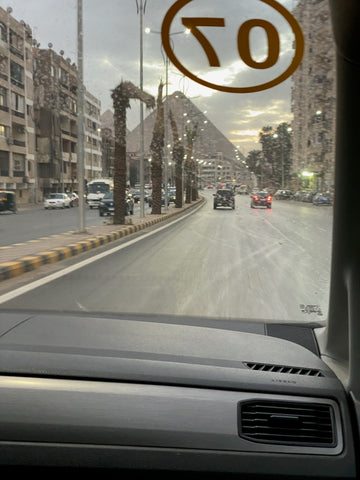
It is so breathtaking and part of it, for me, was this juxtaposition of chaos and perfection. I could not shake off that feeling during the entire trip.
Needless to say, since our Cairo portion got interrupted by a bug, we are planning to be back to see the Giza Plateau, museums and also Saqqara and Dahshur complexes.
Short video medley here in case you just want a quick fix:
Security is everywhere and you have to pass through multiple checks at hotels and airports and your luggage and yourself are thoroughly inspected. We took Egypt Air to Aswan. Flying over allows you incredible views of the vast and arid desert and narrow fertile strips that vary in width along each side of the Nile. The land changes abruptly. Fascinating landscape that people work through every inch. But it wasn't always this way, if you do a little research, Egypt was not always a desert, I believe there were times it was a savanna.

In Aswan, we got on a boat for a 3 day journey on the Nile. Sailing on the Nile is very popular and most companies are not my cup of tea. Ships are large, and packed with people and activities, so I found a dahabiya that had about 6 cabins through Djed travel agency. Walking up to it brought a memory of the Croatian sailing trip I organized for my friends 7 years ago. Sun was so bright and the air was cool and crisp and a bit colder than we anticipated. Apparently this was the coldest January Egypt has had in a long time.
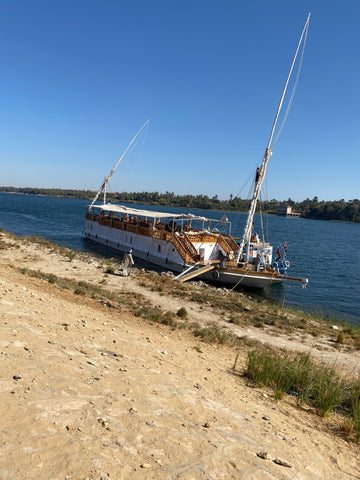
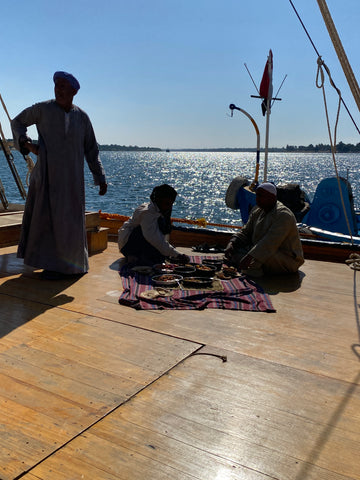
There were eight of us on board. A couple from the Netherlands, retired sisters, one with her daughter and their niece from the USA and the two of us. Staff was amazing and kind, our cook was exceptional and Yasser our guide is a current PHD student of Egyptology. We usually do not go on guided trips, but being that we were in such history rich place we felt it important to travel parts of it with an expert. Plus, my art history classes are buried somewhere in my brain and I was looking forward to the refresh and an add-on course.
We sailed for a couple of hours and made it to the only double temple in Egypt, Temple of Horus and Sobek at Kom Ombo. We docked and were met by young boys and men selling jewelry and trinkets. The exchanges are intense as they REALLY want to sell you something but they are never rude, just haven't a sense of no. I was thinking about how to refuse that I didn't even notice when we walked up to the temple. Even as I type this, I feel a welling up of tears and a lump in my throat. That's one of the ways I experience awe (same thing happens when marathoners run in NYC and I'm crying my eyes out). I know you know nothing can replace the actual experience. For me, touching the hieroglyphs, seeing this visual language completely cover every inch of the structures, the size and organization of the space, building during multiple eras (the further in the temple you go the older it is) , the dual component of the good god Horus (falcon) and not such a great guy Sobek (crocodile), all of it was fascinating.


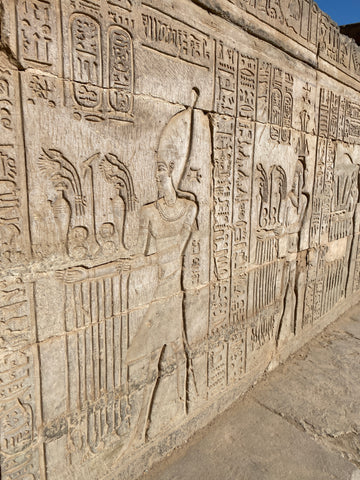

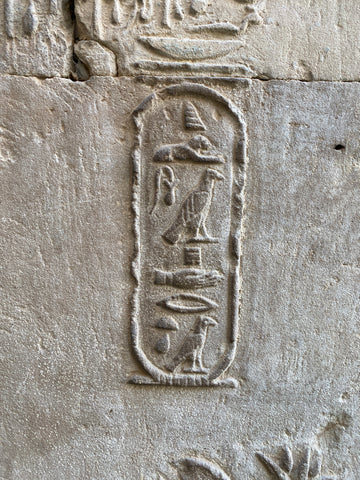
The graphic quality of all the carvings and how methodical and literal they are left an impression on me. Photo below is of the calendar room. It showed a year divided into 3 seasons (sow, harvest, flood) and days. Each day is marked with what was to be offered to the gods when, including notes on the side. This portion of the temple was during pharaon time (there are sections that are Greek and Roman as you move closer to the entrance) . Sidenote, and I haven't checked this for accuracy, but pharaon is not a word they used, Yasser mentioned the word Ber-ah which means great house, which in turn evolved to Fer-ah- great man, thus becoming pharaon.
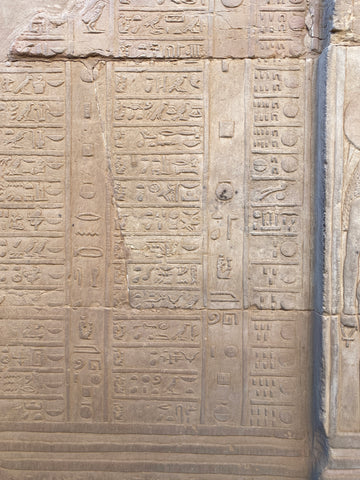
This is where I found Horus, and the Eye of the Horus. For a few thousand years, or rather few dynasties, Horus was one of the titles for all the rulers (they had between 3-5 titles) . Eye of Horus was the symbol of protection and this hieroglyph really stuck with me. Horus was supposed to have healing and protective power, and was often used to ensure the safety and health of the bearer and as such was used as a protective amulet. Seems like we are all reaching for protection of some kind these days.
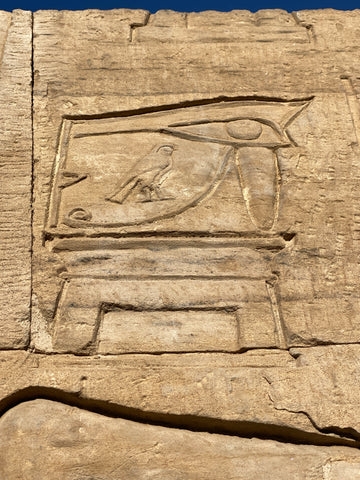
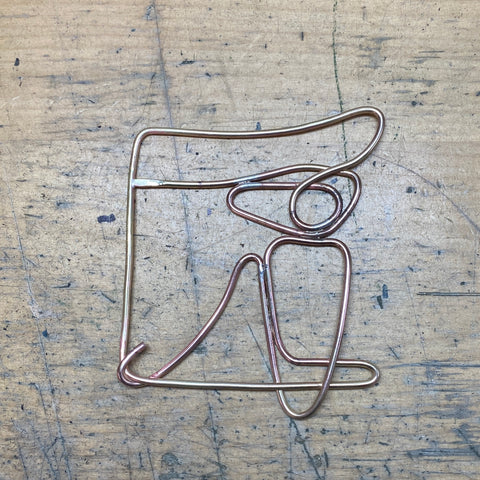
Here is my work in progress, protective amulet; pin Eye of Horus. Pin can be found HERE
Next day we sailed to Gebel Al-Silsila, the quarry for all the temples built in southern Egypt. Most people skip the quarry on their itinerary, but we stopped and enjoyed the quiet. It is right on the banks of the Nile. it's massive and you actually see how all the stones were cut and extricated out of the rocky mountain. They also had small temples inside the mountains and remnants of colorful hieroglyphs. It was so gorgeous to walk in the sand along the banks, beneath this perfect sky. There were about two guards around, one which handed me a limestone heart. They unlock the temple and the access to the mountain as visitors come. I really appreciated so much that it was just 10 of us there. It was magical to just be quiet among the massive rock formations.


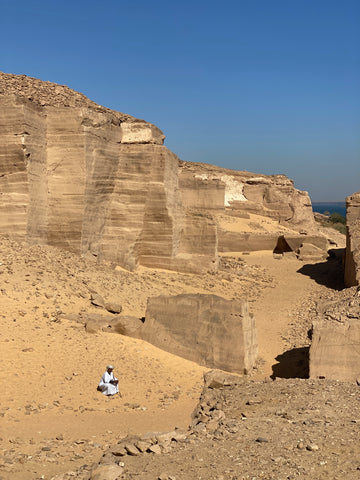
After lunch we sailed and stopped on a small island to spend an hour or so visiting with the local village, that is fully sustained on it's own. They grow their own food, keep animals and live in brick houses that seems unfinished. We found out while visiting with a family that they are always building as the generations are marrying within the family. New floor is erected to accommodate them and the family they will make. People are friendly, welcoming and we walked through on a Friday, their Saturday as men were on their way to pray. Inside the home is very simple, not a lot of windows as the heat can be unbearable any other time than January. We sat in their living room or rather living space. Furnishings, walls interiors are simple. It felt a bit invasive to be inside a complete stranger's home, but our host was very proud to show us his house, it was one of the biggest ones on the island. Cows and donkeys rested in the valley, there were a few dogs and kids were laughing and saying "hello" "hello" as we walked by..



The Temple of Horus at Edfu is right in the middle of the city. We took a horse carriage to get there from the Nile. I was able to ask for a few carrots from our cook as some horses looked a bit emaciated which always makes me incredibly sad. So many bakeries are outside and they churn Egyptian bread, aish baladi by the minute.

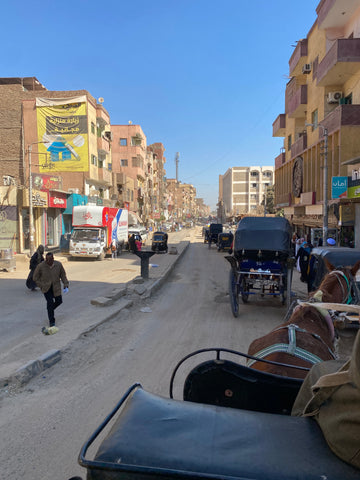

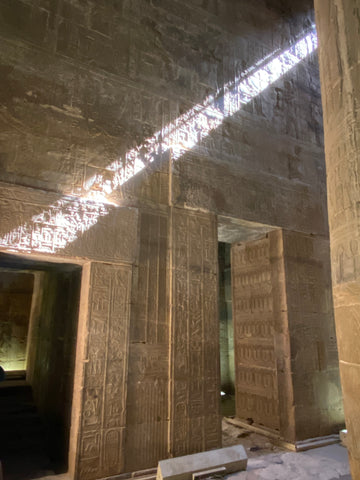
Details are magic in this temple. I am drawn to the Apothecary room with all the potions carefully inscribed in detail and quantity. The photo doesn't do it justice, the whole room is covered with hieroglyphs from top to bottom.
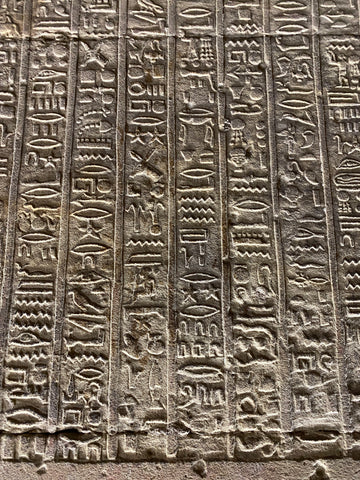
Along narrow walls I found these gorgeous Horus carvings. I keep going back to the graphic quality of these. I captured Horus in this version in a brooch as well.
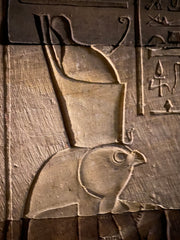

That afternoon we sailed to a El Kab, ancient city of Hekheb, a large open space enclosed by mud brick walls (which surround every ancient city in Egypt). City doesn't exist anymore.
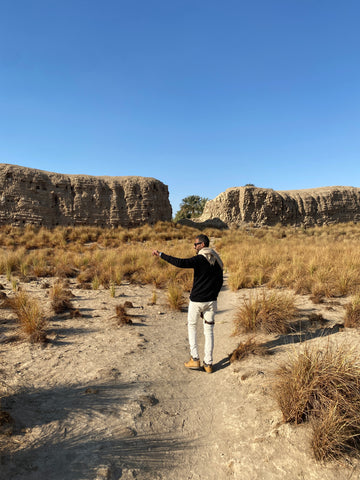
The mud brick walls are wavy- they represent water. This is a vast area and as you walk across this once probably vibrant city, you stumble upon scattered pottery remnants and pieces of history. It has not been thoroughly excavated according to Yasser. Crossing the road (main road leading from Cairo to all points south) you come to the mountain that is pierced with nobles tombs. It is the first time we encountered chambers that depict "everyday" man's life and not aspirational king's afterlife imagery. They are gorgeous, colorful and vibrant. We haven't seen this much color thus far. I loved being in these small, simple spaces.
The leopard print was always in fashion, despite what fashionistas might think! And middle image shows how they depicted multiples of something. Isn't it beautiful?
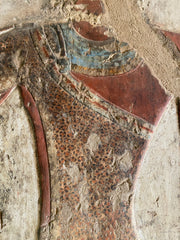
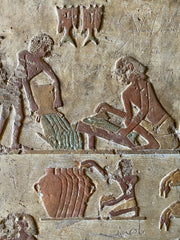
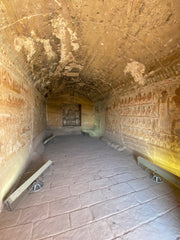
This was our final "cruise" stop, and we spent the evening on the banks of the Nile, where I hung out with the lovely donkey, we both found each other intriguing and the staff prepared yet another delicious meal. I don't think I mentioned how delicious and wholesome food is in Egypt. Everything is grown or cultivated there, they make a lot of satisfying stews, salads, fish, chicken and their delicacy are pigeons. These are nothing like NYC pigeons, fret not!

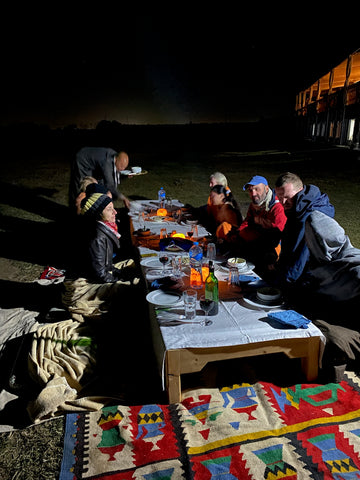
The very next morning we docked at Esna and we had a couple of hours after breakfast to walk around before we got picked up to drive up to Luxor. We found the temple of Khnum not too far away and we decided to visit. We passed a few streets which looked completely destroyed, yet people live here. The temple is near the market which is of course flooded with trinkets and souvenirs. I found a lovely cigarette stand that uses cardboard box as a roof among all that. I also love the clay pots with cups on top. You can help yourself to water around town.




Temple of Khnum in Esna was my FAVORITE to visit. Small, mostly quiet and amidst a big restoration, this temple is COVERED in color. It was so gorgeous to see all of that color, even though a lot of the temple was used during Roman time as housing so soot from burning fires covers the ceilings, but I absolutely loved this temple. You tell me what you think:
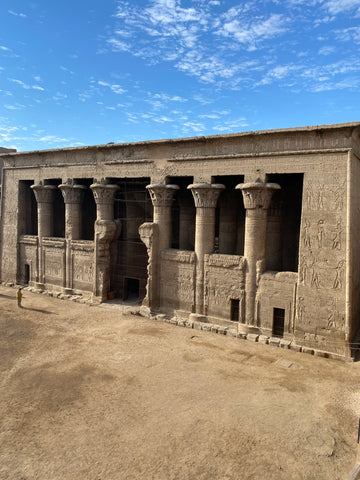


Below image I love so much, just take a look at the different angles of the Eye of the Horus. What does it mean?




Restoration crew was working on the scaffolding, and I asked if I could climb up, but sadly was denied. I would've loved an opportunity to get closer to that magnificent ceiling.
Final stop was Luxor with Temple of Karnak and Luxor temple that are located on the East Bank, right in the middle of the city. The sphinx promenade connects the two. This was a recent excavation and restoration. These temples are grandiose, built by all of the famous kings and queens and just awe inspiring, but I still loved the smaller temples along the Nile the best. There is something about being able to be intimate with the history and architecture that made a lasting impression on me. That video I put at the beginning of the post has a few clips from these temples. Images don't do justice.
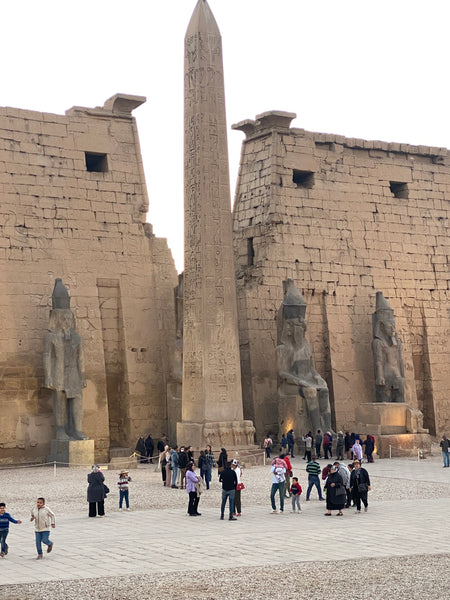

We stayed on the west bank in Luxor (opposite side of the temples and on the side of the Valley of the Kings) because it was quieter and more connected to the everyday people of Luxor. You can ferry between the two banks in minutes. The West Bank has excellent Nubian restaurant my husband found, the sad part was after a long day walk we really wanted a beer and that's only to be found in hotels! Nubian culture is one of many wonderful details about Egypt. I forgot that hoop earrings came from Nubia- that part of it was in Sudan. But the couple on our boat stayed south of Aswan in a Nubian town and absolutely loved being there. I need to research more into the culture, but what I do know is they mined gold and were very wealthy. At some point during Ancient Egypt there were also Nubian kings, short time but still relevant.
Small inns are tucked in the streets parallel to the river and there are a lot of expats that live on this side. Additionally there are animals, donkeys, chickens and vegetable patches. We stayed in a house like Inn, and I believe if it was a wee bit warmer we would've been ok, but Egypt homes haven't any heat, so we had to change plans last minute and find a hotel that does. This gem Al Moudira, totally removed from everything in Luxor was a lovely ending to our trip.
Before we left we spent the day in the Valley of the Kings. It is perfectly aligned with the Karnak Temple, which is meant for daily worship, and the Valley is where the Kings constructed their tombs that would take them to afterlife and hopefully provide the path and sustenance back. They moved away from pyramid tombs which were built in north (Lower Egypt) (I think this is mostly because they were looted) but they always sought a pyramid shape mountain as the spot for the tombs.

There are so so many, and not all are open at the same time, but we chose to see Ramses I and II, Merenptah. I didn't realize we had to pay extra to see Seti I's tomb! Words don't do justice..but here are a few images of the insides of the tombs: Outside is a simple opening and upon entering a deep descending hallway/stairs to get to the main chamber. Walls are fully decorated and colorful. Not sure if this is too early for the Book of the Dead, as that came with the New Kingdom (too many periods to remember, but these are all notes for me to come back to later on as I dig deeper)
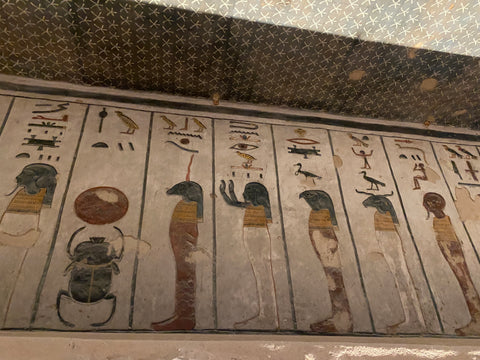


I was so in my element here. I made the Hieroglyph earrings a few years back, not being directly inspired by Egyptian culture, rather after making them seeing the semblance. Imagery was gorgeous and this particular snake represents one the "gates" that the pharaoh had to pass to get to the heavens. They eventually return to earth to find their body to reunite with. That's why they paid so much attention to the preservation of the human body, aka mumification. The King/Queen had to be able to return.

On the other side of the mountain was Queen Hatshepsut's tomb. She was a total badass. Egypt enjoyed a lot of prosperity during her reign, and a friend mentioned that at some point she dressed as a man so she would be addressed as such during official ceremonies. I wrote a little more HERE. There is a bit of family drama with her life and she is so much more colorful than Cleopatra VII that came way after her. Do a little digging for yourself. You will be pleasantly surprised.
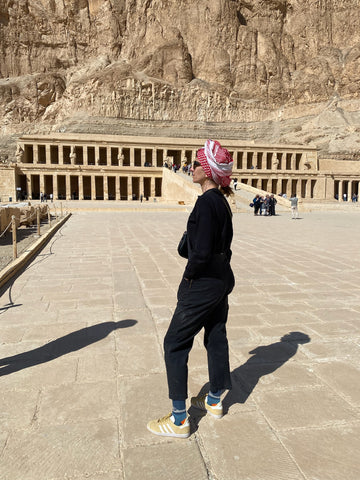
This wasn't all of it. We saw the Valley of the Nobles, where the noble people that served the rulers were buried with their families. Smaller tombs with colorful scenes of everyday life, much like what we saw in Elkab. But most importantly, words and photos cannot bring to life the immense beauty and curiosity about this place. What an enduring culture. Developed on a thin strip of incredibly fertile land. All the massive temples were built right where the desert begins as to not waste a single inch of the workable land. Who they worshiped, how they worshiped. How they dressed, how they lived. And all of this still standing amidst a pretty chaotic and not so perfect current day Egypt. Ancient Egyptians were brutal but there was a reason for everything. We learn that civilizations rise and fall, but it's hard to accept that when you stand between the two worlds and wonder how can today be so far removed from thousands of years ago.
For me, the imagery is deeply imprinted just like it is created. I felt the history as I walked these spaces and I kept wishing I could travel in time and witness a glimpse of this civilization.
I am looking forward to returning and spending some time with the objects since we didn't get a chance to visit the Egyptian museum among other. But here are a few images from the Luxor museum, the mummy, a gorgeous gold necklace featuring beetles, a tiny linen sock and a wonderful carving of a bird.





I hope I arose some interest for you to explore this beautiful, mysterious and wonderful place! I welcome questions:)

1 comment
What a gift to see this part of the world through your eyes!! Thank you for sharing all of these stories. ❤️